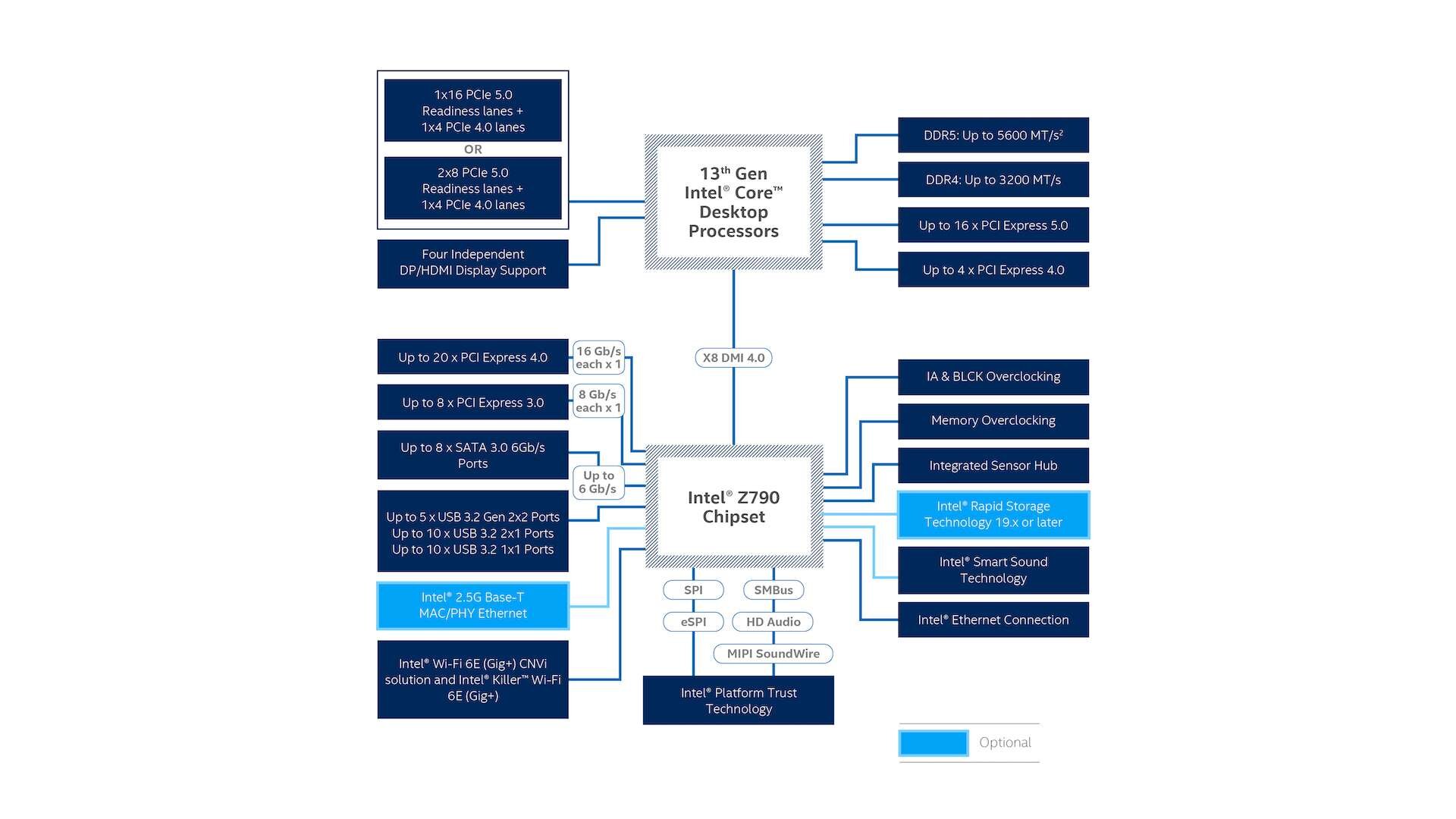After the flagship Z790, the smaller Intel chipsets H770 and B760 for Intel's 13th (and 12th) generation Core CPUs are now starting. Anyone who wants to buy a new motherboard is now spoiled for choice. This article provides assistance and compares the features of the new chipsets.
Z790, H770 and B760: The differences in detail
The new Intel chipsets Z790, H770 and B760 for mainboards with the LGA 1700 socket for Alder Lake (test) and Raptor Lake (test) processors, which are known as Core i- 12000 and Core i-13000.
There are some differences in the functions and the number of interfaces. The table below provides an overview.
or 2 x8 + 1 x4 1 x16 + 1 x4
or 2 x8 + 1 x4 SATA 6Gb/s (max) 4 8 8 USB 2.0 12 14 14 USB 5Gb/s (max) 6 8 10 USB 10Gb/s (max) 4 4 10 USB 20Gb /s (max) 2 2 5 Gigabit Ethernet ✓ ✓ ✓ Wi-Fi 6E (AX211) ✓ ✓ ✓ Smart Sound ✓ ✓ ✓ Optane Support ✓ ✓ ✓ Rapid Storage 19.x ✓ ✓ ✓ PCIe RAID 0/1/5 – ✓ ✓ SATA RAID 0/1/5/10 ✓ ✓ ✓ Overclocking RAM only RAM only CPU + RAM Package 28×25mm 28×25mm 28×25mm TDP 6W 6W 6W Price $31 $36 $57 *HSIO = High Speed I/O Lanes,**DMI = Direct Media Interface for the connection between CPU and chipset
Z790 for enthusiasts and Overclocking
As the flagship of the series, the Z790 offers the best features at the greatest price. It has 46 of the so-called high-speed I/O lanes (HSIO), which can be used universally for various interfaces such as PCIe and SATA. Eight of these lanes are required for the Z790 chipset connection. The Direct Media Interface (DMI) is used in Revision 4.0, which works with 16 GT/s per lane.
 Intel Z790 block diagram (Image: Intel)
Intel Z790 block diagram (Image: Intel)Of the up to 28 PCIe lanes, a maximum of 20 can work with PCIe 4.0 and 8 with PCIe 3.0. PCIe 5.0 comes solely from the CPU: The 20 lanes (4 with PCIe 4.0) can either be configured as x16 + x4 for a graphics card and an NVMe SSD, for example, or 2 × x8 + x4. Up to eight SATA ports can be used.
A total of 14 USB 2.0 ports are possible. A maximum of 10 USBs each with 5 Gbps or 10 Gbps is supported. There are also five USB ports with 20 Gbps.
The Z790 is the first choice for ambitious overclockers, as it offers extended OC functions and also BCLK (Base Clock ) and IA (Intel Architecture), which is not possible with the smaller chipsets, which only allow overclocking of the RAM.
H770 as a middle solution
Now, with the H770, there is a version that is slightly slimmed down compared to the Z790. The number of HSIO lanes drops by only six to 40. DMI and PCIe 3.0 are unchanged, but PCIe 4.0 only has a maximum of 16 lanes. The configuration options for the processor's PCIe 5.0 lanes are also identical to the Z790.
On the other hand, there are clear cuts in the USB ports. Only a maximum of two USBs with 20 Gbps is possible and the maximum number of USB 10 Gbps is also more than halved at 4. In addition, you have to do without two USB 5 Gbps. Up to 8 SATA ports are also possible.
B760 for getting started
The new entry is the B760 chipset with even less equipment than the H770. Only 28 HSIO lanes are available, four of which are reserved for DMI; the connection to the CPU is therefore half as fast as with the H770 and Z790.
With four PCIe 3.0 and ten PCIe 4.0, the maximum possible PCIe lanes are exactly halved compared to the Z790. The CPU can still use 20 PCIe 5.0 lanes, but their configuration cannot be varied.
The number of SATA ports has been halved to four. USB 10/20 Gbps has the same features as the H770, but USB 5 Gbps is reduced to a maximum of 6 ports.
In addition, unlike its larger siblings, the B760 does not support NVMe RAID.
Boards with B760 and H770 are first
Even if the B760 looks like a Z790 cut in half, its equipment is definitely sufficient for normal users. Since the B760 mainboards are significantly cheaper than the Z790 models, this platform is likely to establish itself as the new standard.
But first of all, the mainboards with B760 and H770 chipset may be available. At CES 2023, at least the mainboard manufacturers will present it. Customers also have a choice when it comes to memory, because in contrast to AMD Ryzen 7000, the CPUs not only support DDR5 but also cheaper DDR4 memory. In line with this, the new Intel mainboards will be available as DDR4 and DDR5 versions.
CES 2023 (January 5 – 8, 2023): ComputerBase is on site!